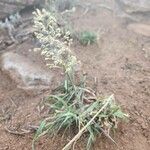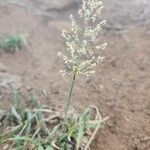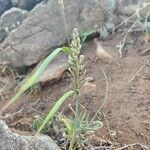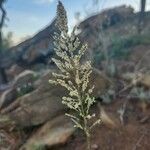Tufted perennial, the basal sheaths neither fibrous nor broad and papery; culms mostly 90–160 cm. high and 2–5 mm. in diameter at the base, but sometimes less.. Leaf-blades flat, or convolute when dry, up to 50 cm. long, 3–10 mm. wide, tapering to a flexuous filiform tip.. Panicle narrowly pyramidal, 20–45 cm. long; primary branches spreading horizontally at anthesis, subsecund, densely spiculate along their whole length, the lowest mostly 5–10 cm. long.. Spikelets 1.7–2 mm. long, green or purplish; lower glume broadly oblong, 0.2–0.6 mm. long, hyaline, nerveless; upper glume broadly oblong, 0.5–0.8 mm. long, 1/4–1/3 as long as the spikelet, obtuse; lemma ovate-elliptic, as long as the spikelet, acute; anthers 3, 0.6–1.1 mm. long.. Grain obovoid, 0.8–1 mm. long, conspicuously truncate.
Spikelets (1.4)1.7–2(2.3) mm long, green to greyish or purplish; inferior glume 1/5–1/3 the length of the spikelet, broadly oblong, hyaline, nerveless, glabrous, obtuse to truncate at the apex, sometimes irregularly toothed or erose; superior glume 1/3–1/2(3/5) the length of the spikelet, broadly oblong to broadly ovate or even oblate, hyaline, 1-nerved, scaberulous on the nerve, broadly obtuse to truncate at the apex, often apiculate, sometimes ± 3-lobed, irregularly toothed or erose; lemma as long as the spikelet, ovate-elliptic, acute at the apex; anthers 3, 0.6–1.1 mm long.
Densely tufted perennial, 0.7-1.6 m high; rhizomatous. Leaf blade 100-500 X 2-10 mm; ligule a fringed membrane or a fringe of hairs. Inflorescence a linear panicle, > 5x longer than wide; branches not whorled. Spikelets 1.7-2.0 mm long, laterally compressed, awnless, glabrous, disarticulating above glumes; glumes 1-nerved, both glumes < 1/3 as long as spikelet. Floret 1; lemma similar in texture to glumes, membranous, often shining, 1-3-nerved. Flowering time Nov.-May.
Caespitose perennial without rhizomes or stolons; culms up to 210 cm tall, 2–5 mm in diameter at the base (sometimes less), erect, unbranched; basal leaf sheaths chartaceous, glabrous, slightly compressed to strongly keeled, persistent; leaf laminas up to 50 cm × 3–10 mm, flat (folded on drying), smooth and glabrous on the surfaces and margins, tapering to a flexuous filiform apex.
Densely tufted perennial 700-1600 mm high; rhizomatous. Leaf blade 100-500 x 3-10 mm. Inflorescence linear, more than 5 x longer than wide. Spikelet 1.7-2.0 mm long; glumes obtuse to truncate; lower glume 1/5-1/3 as long as spikelet, nerveless; upper glume 1/3-1/2 as long as spikelet; lemma as long as spikelet, ovate-elliptic, apex acute; anther 0.7-1.3 mm long.
A herb. It is a robust grass and densely tufted. It keeps growing from year to year. It grow 1.7 m high. The leaves are long and roll inwards. They are greyish. They taper to a long fine point. The flowering shoots are 45 cm long. They are very narrow. The branches are erect and 10 cm long. They have small, dark grey-green spikelets.
Panicle 20–45 cm long, narrowly pyramidal; primary branches not in whorls, spreading horizontally at anthesis, the longest 5–10 cm long, scaberulous, eglandular, subsecund, the spikelets densely (sometimes rather loosely) arranged along their whole length, sometimes on short secondary branchlets.
Perennial, densely tufted and rhizomatous, up to 1.6 m high. Leaf blades 100-500 mm long, 3-10 mm wide. Spikelets 1.7-2.0 mm long. Panicle linear, more than 5 times longer than wide; both glumes shorter than a third the spikelet length.
It belongs to a difficult group of closely related species allied to the American S. indicus Linn. (see also S. pellucidus and S. africanus).
Grain 0.8–1 mm long, obovate, conspicuously truncate, laterally compressed and oblong in section.
Densely tufted perennial




